Farewell, Procreate Folio
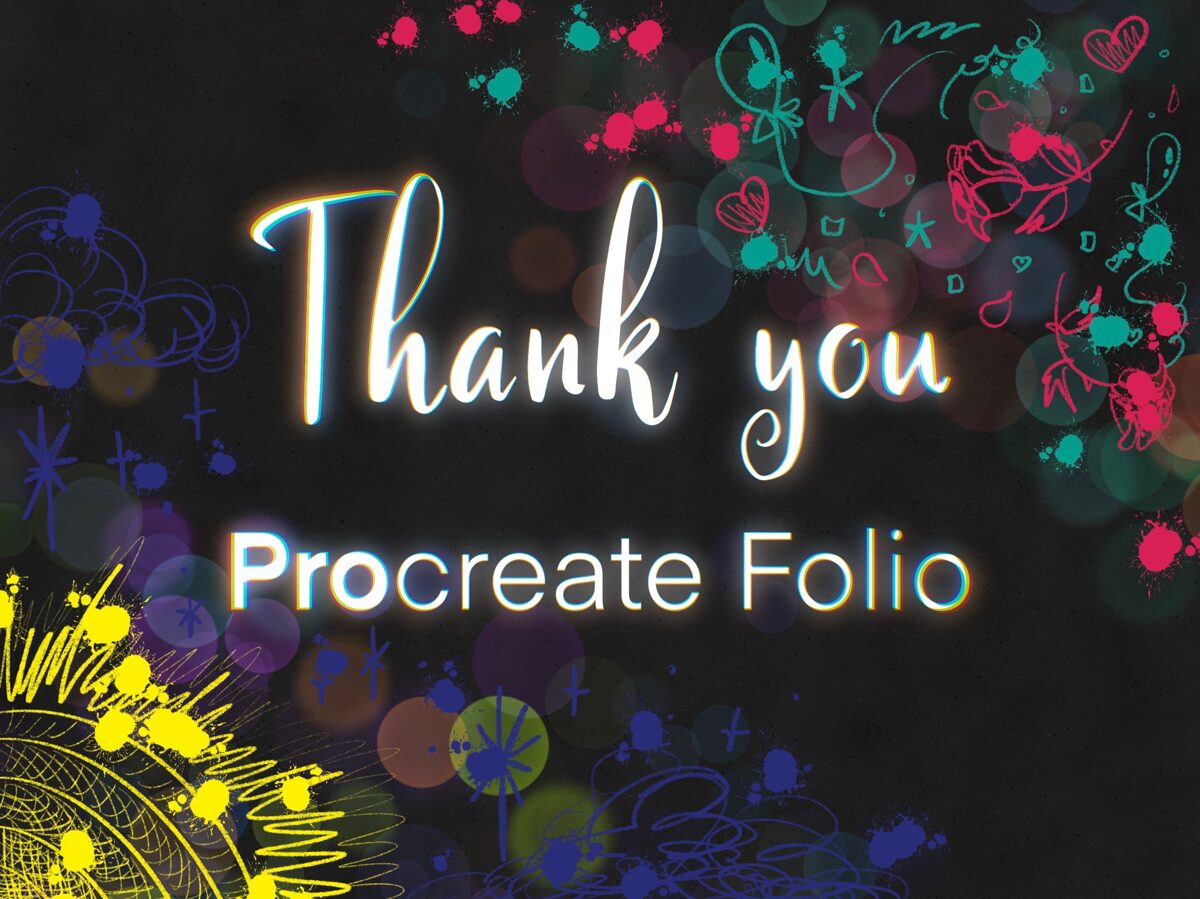
Not too long ago, the team of the digital art software, Procreate, has announced that their social website, Procreate Folio, will be going through major changes. To provide more context, Procreate Folio (launched in 2018) is an art-driven social platform where users around the world can post work specifically based on art done on Procreate. Of course rather than just post art, users can also write posts in a discussions page whether it be based on concerns regarding the software, ideas to strengthen Procreate's future, or just to offer a sweet greeting.
Since May 29, 2025 however, Procreate Folio will no longer be the artistic social network it used to be as it was announced that all users will no longer be able to post content their and most display pages for new artwork has shut down. This is so because moderators want to reduce the overwhelming task in clearing off spam bots and harmful content. However, its discussions page will remain active, so that doesn't mean the entire site will completely defunct. Unfortunately, despite resolving such problems, the experience on Procreate Folio will never be the same as before.
I remember joining the platform on April 18, 2018, which was shortly after I first downloaded the Procreate app on my first iPad Pro. Throughout the past seven years, I enjoyed my experience posting art during my late teens as Galaxy03 and sharing how much my art has changed as a college student as Galaxy22. Another aspect that I find Procreate Folio very special was that its visual web design was rather clean and tidy and its community was more simple and calming compared to some other platforms. But even after expanding my art in other parts of social media, to building my own website, little did we know that this precious site would come to end (partially).
While I'm very disappointed that Procreate Folio's social pages will be shut down, I'll never forget how much it helped improve my confidence in sharing my art to the world as well as influencing me to expand my position in the art world and techniques in technology. So even though it'll be hard to see Procreate Folio go, I just want to say thank you to the team that helped made it possible from start to finish. Best of luck for your future and hopefully you'll find more technical improvements someday.
Snow in Shimogamo Shrine
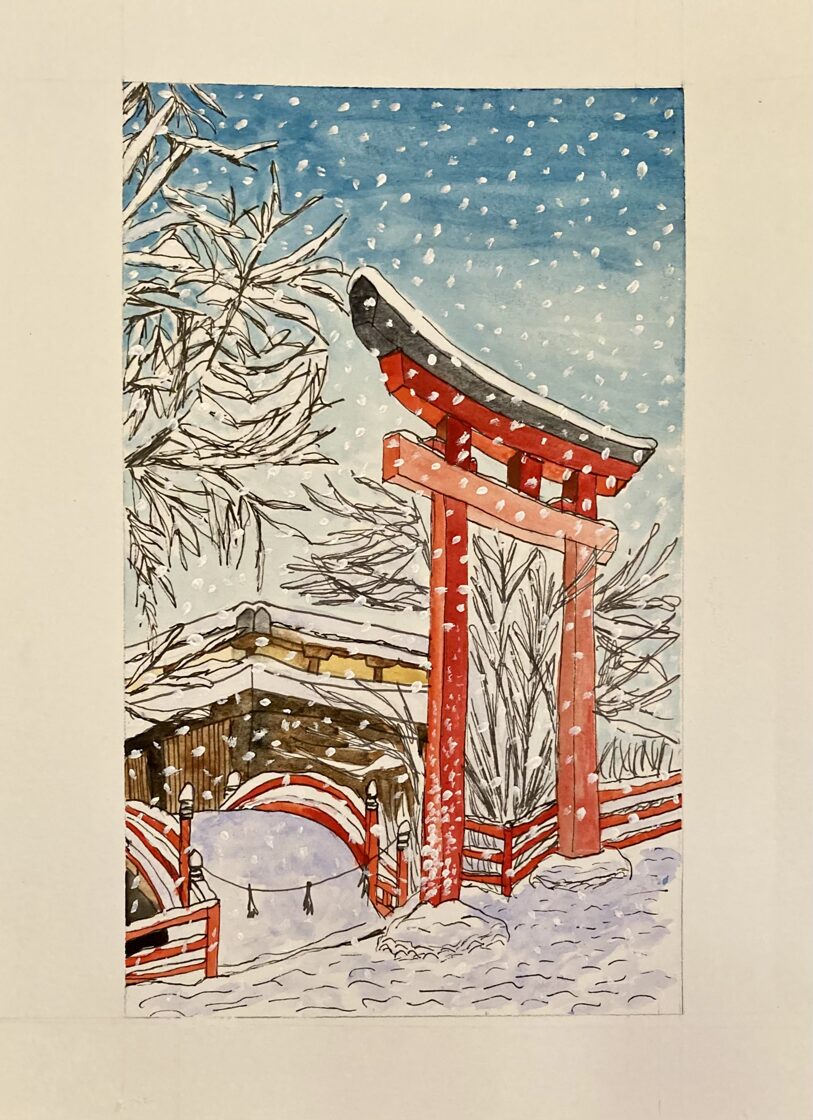
Disclaimer: This article was originally published in the previous host, GoDaddy on January 10, 2025, and has been transferred for preservation.
You may have heard the news, and yes, a snowfall is coming to Dallas. Who could guess that I, a Dallas resident, made a painting about the snow in Kyoto, Japan? Snow in Shimogamo Shrine is my first artwork, completed in 2025. As you can see in the picture, Snow in Shimogamo Shrine depicts the titular shrine during winter with its bold red gateway powdered with fresh white snow and the nearby buildings, bridges, and trees. It is inspired by the iconic Japanese art movement Ukiyo-E.
Ukiyo-E was prevalent throughout the 17th to 19th centuries. Its name originated from the religious context of Buddhism, referring to ephemeral nature and human life. Most art based on the movement commonly depicted subjects of beautiful women in elaborate clothing, kabuki actors, sumo wrestlers, scenes from history and folklore, travel scenes, landscapes, and nature. Most Ukiyo-E artwork was composed of paintings and woodblock prints, such as the most notable composition, The Great Wave off Kanagawa (1831) by Katsushika Hokusai. Although Ukiyo-E art was initially considered "low" by wealthier classes, it holds great significance in craft and techniques. The artwork depicted various themes and stories, including history, fiction, and current events. It also expanded on contemporary innovations, concerns, and tastes, proving art can be populist and highly sophisticated.
Snow in Shimogamo Shrine is not a woodblock print but a painting using watercolor and spots of white acrylic paint. The lines are drawn with a drawing pen. I created this piece to challenge myself to make art based on buildings and structures while depicting the beauty of snow and winter, especially during the holidays. Seeing snow is precious, as there aren't many snowfalls in Dallas. Either we don't get any snow for the entire year or only get snow for just a few hours to a few days. Whenever we get snow, seeing all the houses, trees, and grass covered for a winter wonderland looks magical. Then it's the perfect time to walk around when the snow is still powdering the town, go out sledding, build a snowman or two, make snow angels, have snowball fights, or just watch from the window while drinking hot cocoa by the fireplace. And when it's all over, you may want to gaze at my first 2025 composition portraying the elegances of winter in a distant location.
The Baker's Dozen and the Yearly Ornament
Disclaimer: This article was originally published in the previous host, GoDaddy on December 13, 2024, and has been transferred for preservation.
At
last, the semester is over! The holidays are rolling in, and everyone
can relax after a handful of stressful months of work and school! For
this article, I’d like to describe two compositions created as final
projects before winter break, one from the Begining Sculpture and
another from Beginning Metalsmithing and Jewelrymaking.
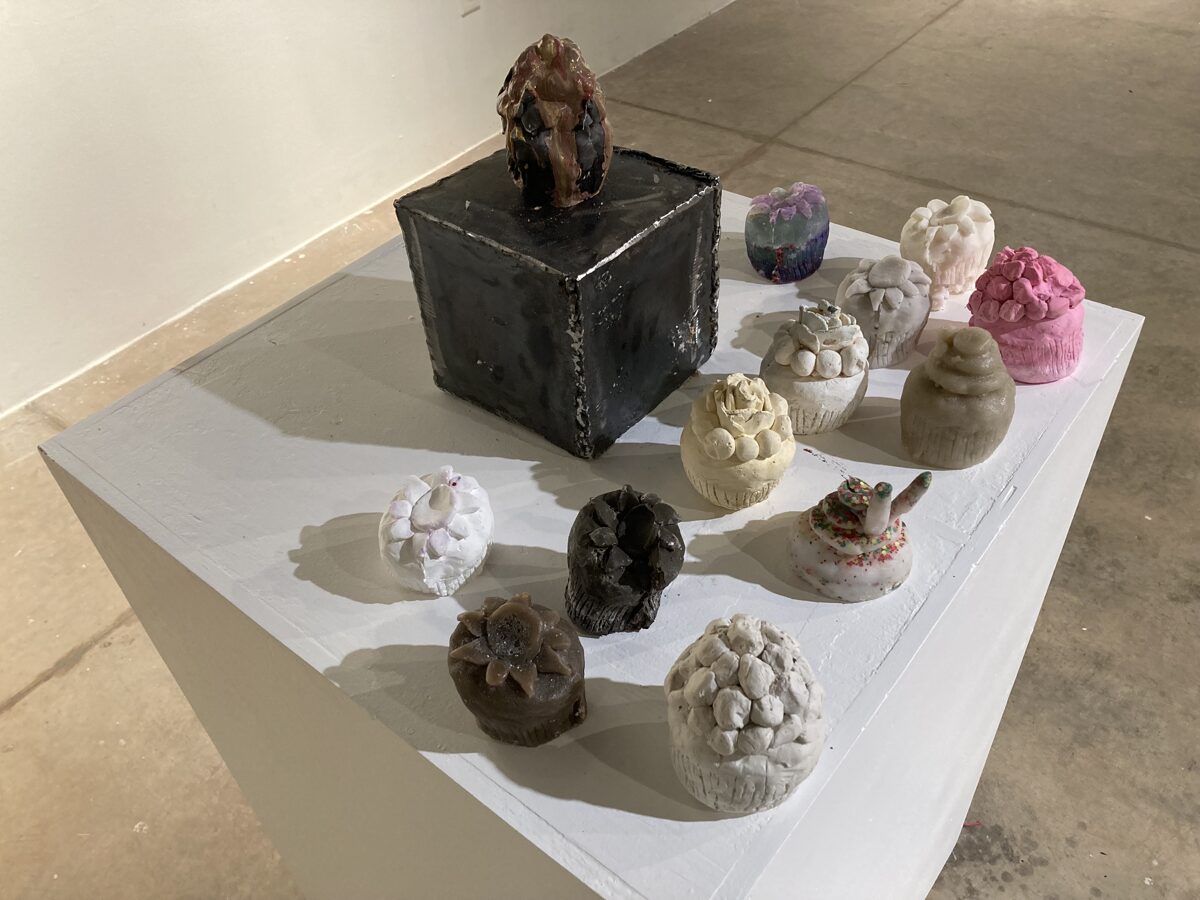
The Baker’s Dozen was a casting project where I had to make thirteen casts from four molds resembling cupcakes. Each cast is made out of thirteen different materials:
- Hydrocoal Plaster
- Hard Putty
- Water Resin Plaster
- Plaster of Paris
- Clear Resin
- White ResinCeramic Resin
- Beeswax
- Paraffin Wax
- Coconut Wax
- Soy Wax
- Crayon Wax
- Mixed Wax topped with Acrylic Paint
In all honesty, I may have been taught woodworking, welding, and ceramics in high school, but I have yet to learn casting, and that was a significant struggle. For instance, I had to make multiple mother molds out of Paris bandages tirelessly, keep watch of leaks coming out as I applied a new cast, build new molds after accidentally tearing apart old ones, mix or heat casting material on the stove(yes the sculpture studio had one, believe it or not), and wait to pour new layers of the next cast. This was my most stressful project in the class, and I couldn’t finish all the cupcakes by its deadline, December 2nd. I was hoping I’d complete the project during Thanksgiving break, but I had a lot of trouble with mixing and measuring the resin, which was a bit of a disadvantage. Luckily, I wasn’t the only student in the class with less than thirteen casts completed that day (I only had ten, for example). Despite this, I refused to give up and finished the last three cupcake casts on the 6th and took some lovely photos of them the night I completed The Baker’s Dozen.
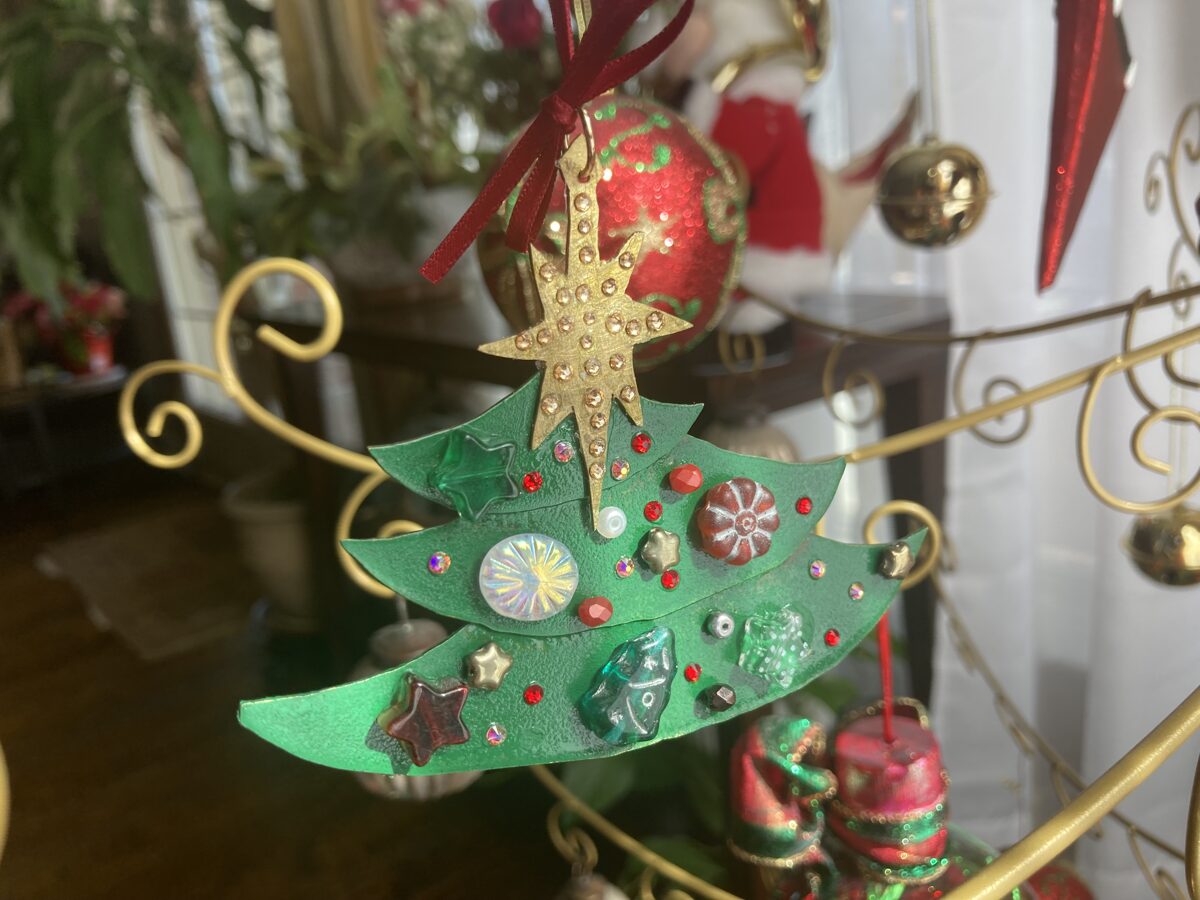
Yearly Ornament
Since my parents were married, they wanted to start a tradition of buying a unique yearly ornament to hang on the Christmas Tree. The tradition grew with my and my two brothers’ first Christmas ornaments and continued when we bought any beautiful ornament worth hanging each year. Instead of purchasing another yearly ornament for 2024, I vowed to create a new one for the Jewelry-Making class.
This Christmas Tree-Shaped ornament is built from sheets of brass. The three pieces of brass that make the tree are coated with green spray paint and decorated with holiday-themed beads and colored rhinestones. The rhinestones represent twenty-nine years since the tradition began. The next piece of brass is the Star Charm (my first jewelry piece and assigned for the Shilouette Project), which is glued on top of the tree and decorated with golden rhinestones to make it look more flashy. While making it was a bit time-consuming, this ornament ought to be my favorite project in class.
While my first semester as a junior was nowhere perfect, I have learned to improve my skills in my last two sculpture classes, and I am proud to have completed all of the required 3D Distribution courses. I look forward to starting two new accomplishments in my degree: completing three art electives (starting with Intermediate Printmaking) and a minor in Art Entrepreneurship (starting with Financial and Managerial Accounting).
What to Expect when applying for Art in College
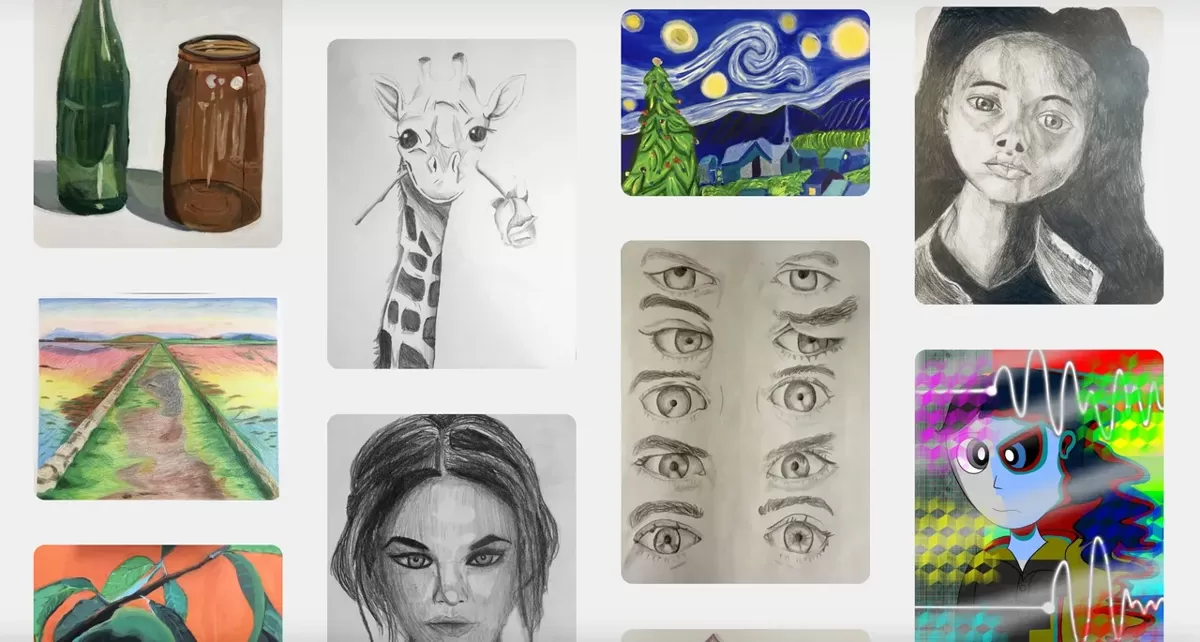
Disclaimer: This article was originally published in the previous host, GoDaddy on November 29, 2024, and has been transferred for preservation.
Applying to an art school, whether it be part of a university or entirely on its own is challenging. High school students need to fulfill many goals on their next journey to college, such as building a solid portfolio and achieving a high GPA on their report cards. Of course, some may not know where to start or what work they plan to submit, so I created a starter guide on what high school students should follow before they’re prepared to continue making art for college.
1. Create art even out of school.
You’ll need to do more than just make art during the school year to build your portfolio. Consider practicing making art at home. You can find some references in your photo album or online and turn them into an artistic composition. Spend time making sketches or paintings at home or during programs that teach art outside your school. Art teachers will also expect you to create art as a part of your homework(on weekdays and weekends), not just during class.
2. Avoid submitting fan art.
Making art based on your favorite TV shows, web series, movies, anime, mangas, cartoons, comics, and video games is fun. Unfortunately, colleges are most likely not going to accept fan-made art for two good reasons:
- Fan art is commonly based on media copyrighted by various companies and may cause copyright infringements (even if you credit the owners and original creators).
- Colleges will find fan art “uncreative” and expect you to make art based on original content from your imagination and vision.
Of course, making original art isn’t always easy. Some great ideas are creating compositions of objects, portraits, models, and landscapes from pictures or real life. This doesn’t mean you should abandon your love and skill for fan art, but including it in your portfolio is not recommended.
3. Rely on a variety of mediums, not just digital.
Depending on the college you plan to attend, art schools expect you to learn a variety of media, such as painting, digital graphics, printmaking, sketching, sculpture, jewelry, and more. The classes you may be taking in high school may also expect you to achieve art in various mediums. Of course, every school is different and may not be able to teach the same mediums colleges do, but you can try your best to achieve the mediums high schools are willing to teach. Typically, the most common subjects taught to high schoolers are painting, sketching, ceramics, and photography.
4. Apply for both universities and standalone art schools.
It will take more than just one school to apply before you’re officially an undergraduate student. You can choose a variety of art schools that are all on their own, or you can select an art school that’s part of a university. You should apply for both kinds of schools depending on your preferences because some may offer better opportunities for your preferred majors. In contrast, others may have better learning accommodations to help you prepare for your future college journey.
5. Take achievement tests and write essays for college.
Many teachers may insist that you take achievement tests (SAT, ACT, Stanford 10, STAAR, etc.) and essays for college. While not every school requires you to participate in these assignments (especially since the COVID-19 pandemic), they are still recommended because they can help students win a higher chance of getting accepted into the colleges students are applying to and wish to attend the most, especially if they are applying for a fine arts major.
6. Interview with college advisors
Another essential strategy is interviewing with college advisors. High schoolers will likely have to meet with advisors depending on the school they plan to attend. Most of the questions advisors will ask students (besides names and grade levels) are their preferred majors and why they want to apply for the school. Students are also welcome to ask advisors questions if they need additional information. Advisors in art schools will also like it if the students share some of their compositions, and if that’s so, here’s what students will need to know when sharing their work.
- They should include clear and crisp digital photo files of their work (PDFs, PNGs, and JPEGs are most recommended).
- They must be the most substantial works they made in their portfolio.
- The student must briefly describe the work(s), including explaining its name, medium, year of creation, and why it was created.
7. Limit the work you plan to include in your final portfolio.
As you continue to improve your artistic talents, your compositions will be stronger than initially. Usually, the best works of art in a high school portfolio are created during the student’s junior and senior years. Do not expect your choice of art schools to let you submit all your high school compositions because they do not have the time to review them all. The average range of works you can submit digitally is between ten to twenty. Please take the time to determine your top ten to twenty best works before you’re ready to share them with various colleges.
8. Submit your work for art festivals and competitions for high school students.
Rather than just submitting your art to colleges, you can also share your work at arts festivals and competitions. There are many significant events for high schoolers (and at lower levels) to participate in, whether from private or public schools. Even if you don’t get a lot of recognition or awards, what matters is that you try to showcase your work during public events, proving to colleges you are not afraid to share your art with large audiences.
As a junior college student, I am sharing some tips and tricks I experienced before I graduated and attended the School of Art at Texas Tech University. I hope that high schoolers (and their parents) reading this article will find these strategies beneficial if they also plan to major in art. This article encourages students to know what to expect when searching for the best art college to give them the advantages they will need starting at an undergraduate level. In a few years, I'll gladly create an article with more tips and tricks when applying for a master's degree in art.
The Fall Portfolio (So Far...)
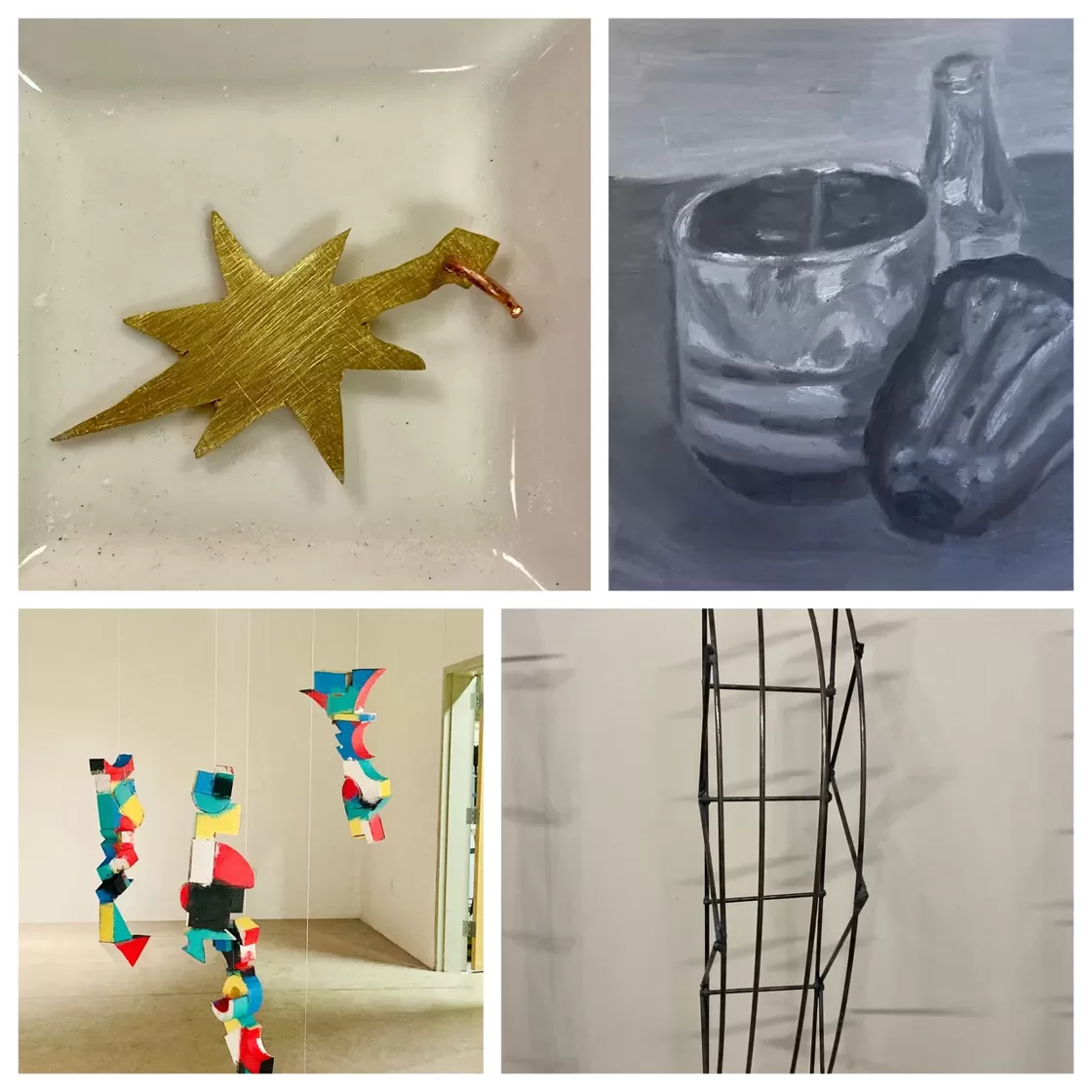

Disclaimer: This article was originally published in the previous host, GoDaddy on November 15, 2024, and has been transferred for preservation.
Students must wrap up everything before final exams, essays, and critiques around November and December. Although I feel a bit behind this semester, I’m trying to finish as much work as possible before Thanksgiving and Christmas break. I have a handful of completed artwork to showcase, which will be listed and described below!
The Bauhaus Blocks
- Medium: Wood and Acrylic Paint
- Class: Beginning Sculpture
A series of towers consisting of wooden blocks cut from sawblades, smoothed from sanding machines and painted with acrylic paint. These abstracted blocks were inspired by the aesthetics of the Bauhaus but with some distorted twists.
Charcoal Cat
- Medium: Charcoal on Paper
- Class: Painting Club
Recently, I signed up for a painting club, where we demonstrated various art techniques. Although charcoal is not a painting medium, we did learn how a charcoal drawing can be as complex as an actual painting.
The Bell, the Bottle, and the Painting Can
- Medium: Oil Paint on Canvas
- Class: Painting Club
Here is another composition from the painting club! This one, in particular, is a monochrome still life. The objects assigned for this painting are a brass bell, an empty glass bottle, and a silver-colored paint bucket. This painting helped me demonstrate how to paint textures made of reflective material.
The Byzantine Bracelet
- Medium: Copper and Glass Beads
- Class: Beginning Jewelrymaking and Metalsmithing
This braclet was built in the style of a Byzantine chain and decorated with tiny glass beads I brought from a coffee shop during a youth group meeting (we were doing a little craft session that evening).
The Rainbow Rail
- Medium: Steel
- Class: Beginning Sculpture
A sculpture made of thick metal bars welded together, resembling rainbow arches. The model's name comes from welding the rail using a blowtorch and thin wire rod.
Rigid Panels
- Medium: Digital Prints
- Class: Story Development for Animation
A personal little comic strip where I introduce myself and how I want to become my artist and create a strong portfolio that others can appreciate in the future.
Star Charm
- Medium: Brass
- Class: Beginning Jewelrymaking and Metalsmithing
A simple eight-pointed star cut from a sheet of brass is used to demonstrate how to create charms by cutting off various shapes. A drill made a while on the highest point of the star to hook the ring, thus making it perfect for a necklace.
Yin-Yang Pin
- Medium: Brass and Copper
- Class: Beginning Jewelrymaking and Metalsmithing
A pin resembling the yin-yang fish in geometric style. With one fish cut from a brass sheet and another from copper, these two were to be soldered (similar to “gluing” pieces of metal together, but with pieces of solder wire and a blow torch) to form the complete design of the pin.
As I said earlier, I will work hard to finish all my other compositions before the semester ends. Therefore, this article will be continued with another list of recently completed artwork for the same three classes.
The Rainbow Rail and the Bauhaus Blocks
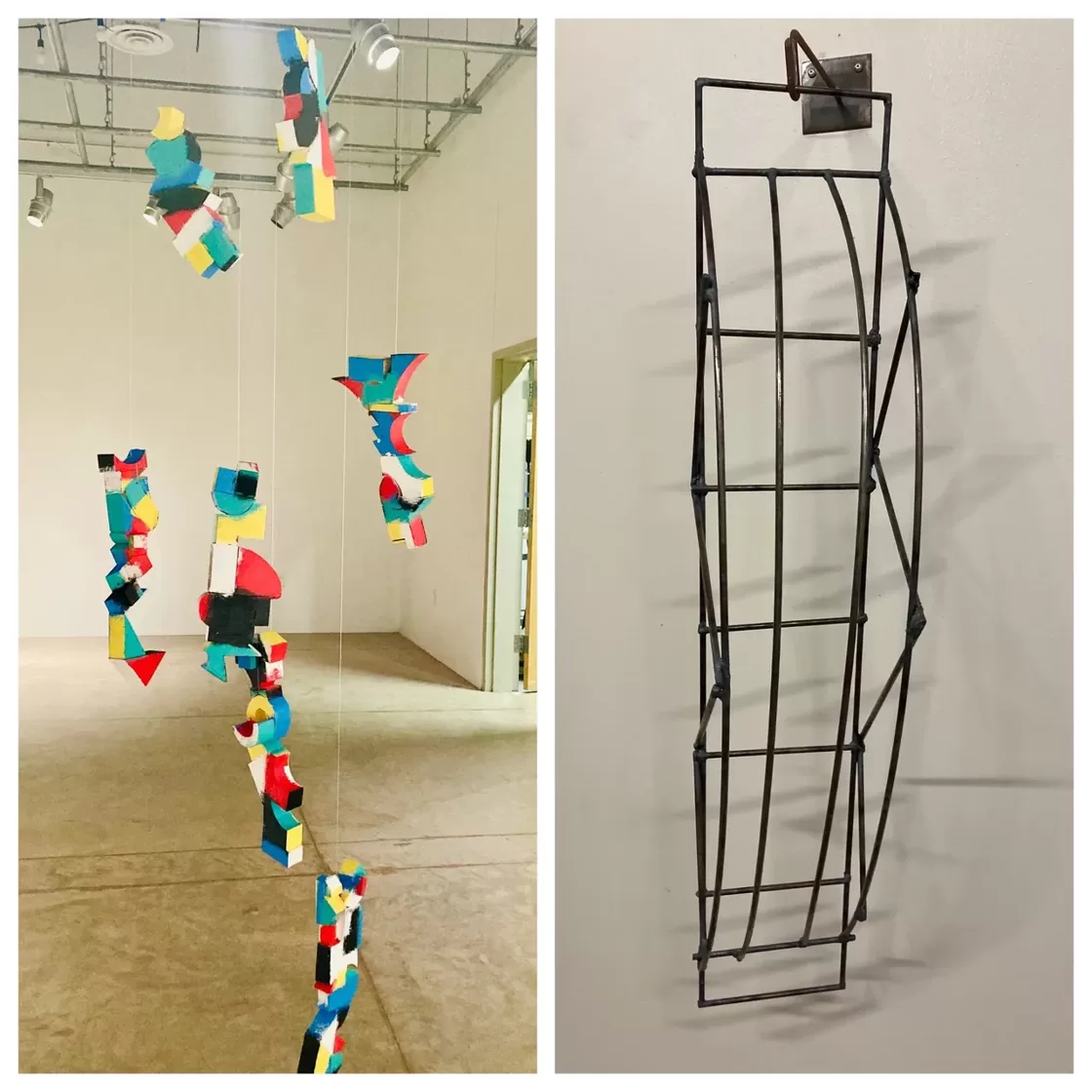
Disclaimer: This article was originally published in the previous
host, GoDaddy on November 2, 2024, and has been transferred for
preservation.
In my second article, Another Year in Texas Tech, I mentioned that I would apply for a sculpture class. As the other classmates and I learned, we created two kinds of sculptures based on metal sculpting and woodworking. Therefore, we had reached halfway through a whole semester of Beginning Sculpture. Thanks to my high school experiences in wood and metalwork, I am proud to discuss my latest two 3D projects: The Rainbow Rail and the Bauhaus Blocks.
The Rainbow Rail
The Rainbow Rail is made of thick metal bars welded together. The outer layer of the rail resembles the arches of a rainbow, hence the model's name. When I did metalwork in high school, we had to learn the fundamentals of grinding, plasma-cutting, and welding pieces of metal when making a sculpture. At the time, we were taught how to weld with a handheld welding gun in which the ultraviolet power activated the wire attached inside. In the college sculpture class, I learned a much different technique in welding: using a blowtorch (activated with combustion of oxygen and acetylene) and a thin rod of wire to hold while welding the metal pieces. Of course, we needed to test our skills with this unfamiliar welding by creating lines of melted wire from steel sheets. Not too late, we finally could begin our final project of welding a rail. It took us weeks to shape the thick rods, assemble them to the proposed structure, and weld them to their complete build. As soon as everyone's rails were full, we each performed a "tightrope" recital by balancing our feet on our rails. The process involved putting our rails on the edges of two heavy tables. Then, we could balance on our rails (with optional assistance from the professor if we were afraid of heights) and see if our weight didn't crush our projects, thus starting all over. I felt terrible for some of the kids whose rails broke apart. Some looked frail or sloppy, but that didn't mean they could make up for what went wrong and rebuild themselves into something better than before. I'd say that working with metal was probably a complicated subject for us, but we managed to try our best in the long run.
The Bauhaus Blocks
Moving on from metal sculpture, we started new projects for woodworking. They were inspired by the Bauhaus, an innovative art school in Germany from 1919 to 1933. The school was known for developing modern art and mass productions in various fields. However, financial struggles and the rising plague of Nazism led to the closure of the Bauhaus. Thus, artists and staff members fled to Chicago and Tel Aviv. They escaped to share their modern art and concepts. Considering that the Bauhaus artists created innovative products like modernized chess and building blocks. This inspired me to make wooden sculptures using these building blocks. Development began with cutting off multiple pieces of wood into various shapes with a mechanical sawblade. The pieces were smoothed by a sanding machine and were glued together in structures that would seem impossible to build solely by hand. The blocks were then painted with six primary colors: white, yellow, red, blue, green, and black. These colors came from the original building blocks of the Bauhaus since the artists relied on primary colors that helped their compositions and products gain a simple yet modest appeal from other artworks. However, there is one significant twist: the paint on the blocks is splattered in several places, making it look like a collaboration between Piet Mondrian and Jackson Pollock. Overall, I wanted to create these blocks that serve as a tribute to an innovative school that changed the fine arts world but include some uncanny touches of mine.
In conclusion, my journey through the Beginning Sculpture class has been a fine opportunity to refresh my metal and woodworking skills. The Rainbow Rail and the Bauhaus Blocks reflect my learning experiences and artistic growth. While welding challenges tested my perseverance and adaptability, the detailed craftsmanship in creating the wooden Bauhaus-inspired pieces inspired me to embrace a new branch of innovation and creativity. Each project emphasizes the distinct techniques I've learned and pays homage to the influential artistic movements that continue to inspire contemporary art today. As I move forward, I am excited to explore even more new ideas and techniques while carrying these foundational experiences I embraced in the beginning of this class.
Seven Portfolio Apps That Deserve More Love
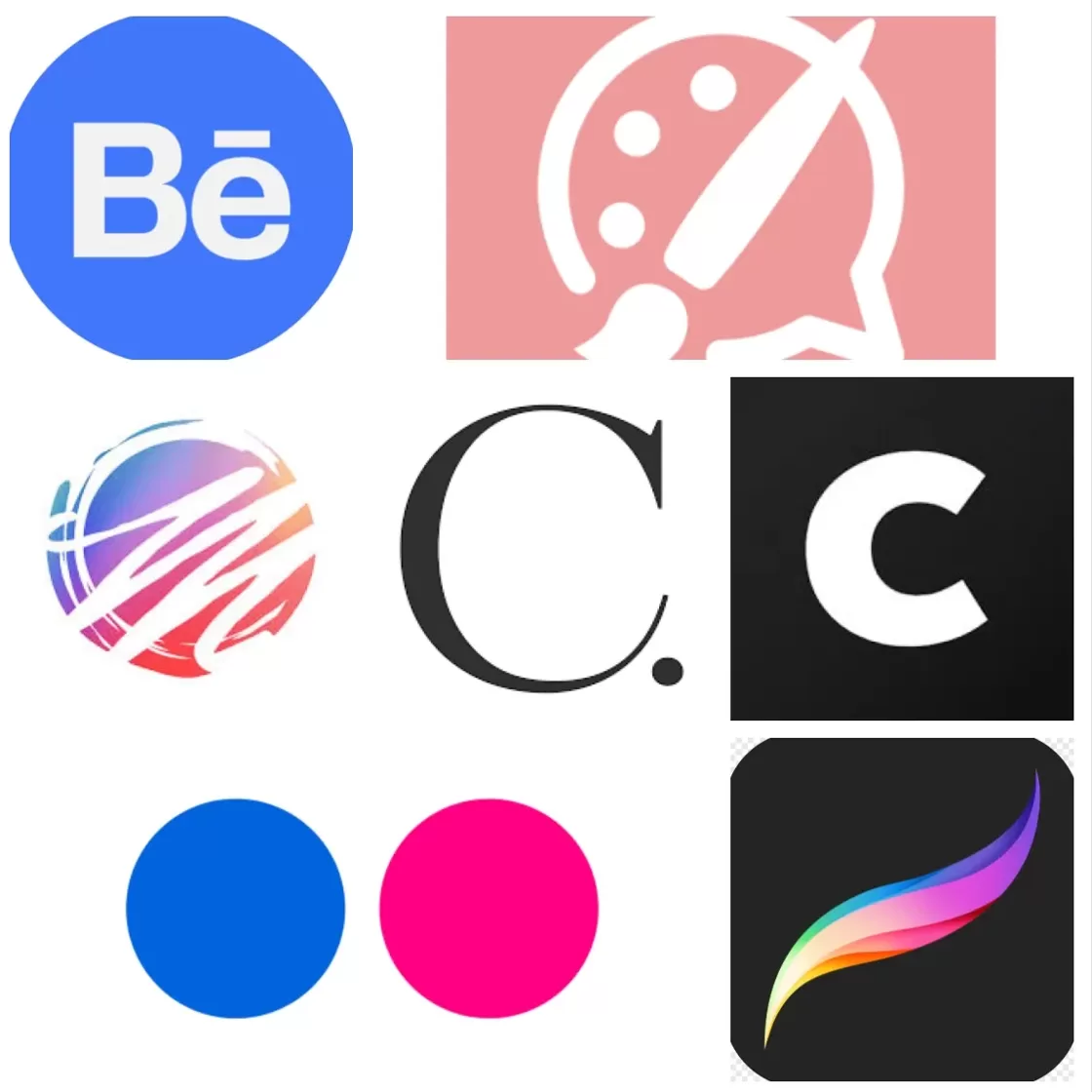
Disclaimer: This article was originally published in the previous host, GoDaddy on October 18, 2024, and has been transferred for preservation.
Have you been unhappy with how mainstream social media apps have mainly changed for the worse? Do you, as an artist, feel like you're not getting as much appreciation as you wish for on platforms like Instagram, Deviantart, or X/Twitter? Have you ever thought of moving to a healthier platform but are unsure where to go? Fear not! Here is a list of seven underappreciated platforms I recommend for artists, including those whose content may be like no other, who need to find fun and friendly communities and opportunities to find jobs regarding visual and performing arts.
Artfol is an independent social networking site founded in 2021 by a small group of passionate individuals. It aims to provide a secure and encouraging environment for artists to share their work online. Artfol accepts all visual art forms and aims to create a welcoming and inclusive community for artists of all backgrounds and abilities. The platform offers a user-friendly experience, customization options, and unique features to encourage participation and community involvement. Artfol is free to use and encourages artists to follow their passions.
Pros
- It is against AI imagery.
- It has special techniques for posting your work, such as critiquing and art challenges.
- The app aims to develop a safe and inclusive community for all artists, regardless of their talents.
- Provides a diverse range of options when posting your art.
- Will limit your time when posting multiple works as fast as possible.
2. Behance
Behance, a division of Adobe, is a popular platform (though not as famous as Instagram or Twitter) for showcasing and finding creative work. Users display their work through profiles of "Projects," which are collections of digital materials with a common topic or procedure. "Projects" have a "View and Appreciation" counter and unique URLs that other users can follow. The "For You" feed shows more projects as users follow more profiles. Projects with a badge may stand out, and "Curated Galleries" showcase the best creative work on Behance.Pros
- Allows options in Creative Commons licensing.
- Strongly recommended for professional creators.
- Simple and fast options for customizing your portfolio and posting colorful articles.
- Provides a diverse range of options when posting your art.
- Includes options for separating your work into different categories.
Cons
- It is owned by Adobe, which has sparked many controversies, such as its support for AI imagery and overpriced subscriptions.
- Not recommended for hobbyists.
Cara is a platform for artist's social media and portfolios, filtering out generative AI imagery for easy access to genuine creatives. Despite some platforms stating regulations against AI, some allow AI art, which is seen as unethical to the platform's staff. Cara aims to provide a user-friendly platform for future creative industries.
Pros
- Is it against AI imagery
- Has a staff that cares and supports their artists
- Provides opportunities for applying for art jobs.
- Provides a diverse range of options when posting your art.
Cons
- Has many bugs.
- It can be prolonged when starting it up.
- It can easily crash, depending on the bug.
- Has a poor third-party AI detector.
- The app may mistakenly detect your art as AI, even if it isn't.
Offering top-notch portfolio tools, networking opportunities, and access to countless job ads from well-known organizations, Creatively is a free employment community for creatives across all disciplines. Designed by creatives for creatives, it is a vibrant platform where artists can exhibit their work and where businesses and brands can find and hire incredible talent.
Pros
- Provides opportunities for applying for art jobs.
- Strongly recommended for professional creators.
- This includes skills that are used to describe the artist, such as social media entrepreneurship, painting, graphic design, etc.
- Includes options for separating your work into different categories.
Cons
- May have a limited list of skills, including those not featured in the app.
- Some users may have difficulty applying for jobs from faraway places (I mostly recommend remote jobs).
Flickr is a global digital media platform created by Ludicorp in 2004 for online picture management and sharing. It allows professional and amateur photographers to share high-resolution images, publish their pictures, and host their images on the platform. Flickr caters to novices and experts, offering a platform for browsing digital galleries and discovering popular images. Flickr provides sophisticated tools to engage the community and discover new content despite the competition.
Pros
Allows options in Creative Commons licensing.
Simple and fast options for customizing your portfolio.
Includes options for separating your work into different categories.
Cons
Artists may not get well recognized compared to photographers.
Has ads that may annoy users.
It has a limited number of posts when not using a premium option.
Art Social is a community the Milan Art Institute created to foster creativity and connection among artists of all skill levels. It offers a platform for artists to showcase their artwork, interact with artists worldwide, and connect with local artists. Members can participate in specialized art classes, listen to podcasts, and access live events tailored to graduates and master students.
Pros
- Strongly recommended for traditional artists, especially painters.
- Includes groups such as the Milan Art Community and Sketchbook Challenge.
- It has special techniques for posting your work, such as critiquing and art challenges.
- Users can check out videos featuring tips and tricks for improving their art and creativity.
- Provides online classes and programs for professional, intermediate, and novice artists.
Cons
- The app does not allow you to use links to share your profile or posts with your friends and family outside the program.
- It may not be recommended for digital artists.
- Online programs may be costly to some users.
7. Procreate Folio
Fun Fact: This was my first social media platform back in 2018.
- Simple options in posting your work.
- Provides discussion boards to post any written works you want to write about.
- The platform aims to develop a safe and inclusive community for all artists, regardless of their talents.
Cons
- Strongly unacceptable to photographers
- It is recommended for artists that use Procreate, but not much for other platforms.
- A limited number of taglines.
- Does not have options to follow artists.
- The platform does not have a mobile app, only a website (though the website can be accessed on a phone or tablet).
Welcome to the Newsletter (Again)

Howdy y'all, and welcome to the remastered newsletter in the new and improved website of The Radiant Galaxy! Lately, I've been transitioning from mainstream platforms to more niche and ethical applications such as Mastodon and Pixelfed. The same has applied when I made the tough decision to transfer from GoDaddy to Mozello. Although they are far from perfect, however, these apps are to give me a chance to start fresh and promote my work in places that suit my needs to continue sharing my art to the world.
As I originally started my first article back in August 9, 2024, I will continue to write and share more articles regarding new compositions, words of advice for improving your art skills, upgrades regarding my presence in social media, and more!
I will also include older articles, but without committing self-plagiarism, I will be sure to include a disclaimer reminding all readers regarding any articles taken from the previous web host.
